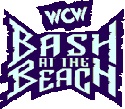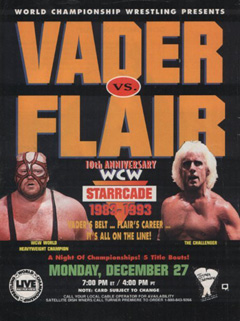| WCW/New Japan Supershow | |
|---|---|
| Promotions | World Championship Wrestling New Japan Pro-Wrestling |
| First event | WCW/New Japan Supershow I |
| Last event | WCW/New Japan Supershow III |
WCW/New Japan Supershow was an annual professional wrestling pay-per-view (PPV) event jointly produced by World Championship Wrestling (WCW) and New Japan Pro-Wrestling (NJPW). It was held in 1991, 1992 and 1993, and was promoted as "Starrcade" in Japan, but not billed as such in the United States due to WCW already having a show called "Starrcade" held each year in December. [1] The show would be taped in Japan and then edited and aired in North America at a later date in WCW. The final two were also the first two January 4 Dome Shows. The events are some of the few pay-per-views not made available for streaming on the WWE Network service.
| Event | Date | City | Venue | Main events | |||||
|---|---|---|---|---|---|---|---|---|---|
| WCW/New Japan Supershow I | March 21, 1991 | Tokyo, Japan | Tokyo Dome | Ric Flair (c-NWA) vs. Tatsumi Fujinami (c-IWGP) in a Title for Title match for the NWA World Heavyweight Championship and the IWGP Heavyweight Championship | |||||
| WCW/New Japan Supershow II | January 4, 1992 | The Steiner Brothers (Rick Steiner and Scott Steiner) vs. Sting and The Great Muta | |||||||
| WCW/New Japan Supershow III | January 4, 1993 | Sting vs. Hiroshi Hase | |||||||
(c) – refers to the champion(s) heading into the match | |||||||||

Bash at the Beach was a yearly professional wrestling pay-per-view (PPV) event produced by World Championship Wrestling (WCW). It was the company's PPV for the month of July, held from 1994–2000. As the title implied, the show centered on a beach theme.
Starrcade was a recurring professional wrestling event, originally broadcast via closed-circuit television and eventually broadcast via pay-per-view. It was originally held from 1983 to 2000, first by the National Wrestling Alliance (NWA) from 1983 to 1990, with the 1983–1987 events specifically held by Jim Crockett Promotions (JCP) under the NWA, and then held by World Championship Wrestling (WCW) from 1988 to 2000.
Michael Laauli Hayner is an American semi-retired professional wrestler. He is best known for his appearances with World Championship Wrestling from 1995 to 2000 under the ring name Prince Iaukea and later The Artist Formerly Known as Prince Iaukea or simply The Artist.

Brian Keith Adams was an American professional wrestler. Adams is known for his time with the World Wrestling Federation (WWF), under the name Crush, and for World Championship Wrestling (WCW) under his real name Brian Adams. Trained in Japan by Antonio Inoki, he was a two-time WCW World Tag Team Champion, a one-time WWF Tag Team Champion and a one-time AJPW World Tag Team Champion, among other accomplishments. He was a challenger for various singles titles in the WWF and WCW, including the WWF Championship. In 2002, he briefly tried a career in boxing until retiring due to back and shoulder injuries.

Clash of the Champions is an American series of professional wrestling television specials that were produced by World Championship Wrestling (WCW) and Jim Crockett Promotions (JCP) in conjunction with the National Wrestling Alliance (NWA). The specials were supercards comprising pay-per-view caliber matches, similar to the World Wrestling Federation's Saturday Night's Main Event series. The Clash of the Champions shows were famous for typically not airing commercials during matches even though many of these matches lasted 20 minutes or more.
SuperBrawl was an annual professional wrestling pay-per-view (PPV) event in World Championship Wrestling (WCW) held in May 1991 and February from 1992 through 2001. Along with Starrcade, Bash at the Beach, The Great American Bash, and Halloween Havoc, SuperBrawl was booked to be one of WCW's flagship pay-per-views. The first SuperBrawl was held in May, but from 1992 onward it was held in February to coincide with the Super Bowl, which inspired the SuperBrawl name. Events from 1992 to 1999 were identified by Roman numerals in its logo and announced on-screen with its corresponding number. The final installment in 2001 was the penultimate WCW PPV as the organization folded a month later. Sting holds the record for most appearances at the pay-per-view with eight. In 2015, all WCW pay-per-views were made available on the WWE Network.

BattleBowl was a one-time professional wrestling pay-per-view (PPV) event produced by World Championship Wrestling (WCW). The show took place on November 20, 1993, at the Pensacola Civic Center in Pensacola, Florida. The event featured only the "BattleBowl Tournament", where the first round consisted of eight tag team matches where the teams were drawn at random in a "Lethal Lottery". Members of the winning teams would advance to the BattleBowl battle royal main event. Vader, who was already the WCW World Heavyweight Champion at the time of the show, received a ring for winning the tournament.

Starrcade '93: 10th Anniversary was the 11th annual Starrcade professional wrestling pay-per-view (PPV) event produced by World Championship Wrestling. It took place on December 27, 1993, from the Independence Arena in Charlotte, North Carolina. This was the first Starrcade to feature Ric Flair since the Starrcade in 1990.

The 1996 Starrcade was the 14th annual Starrcade professional wrestling pay-per-view (PPV) event produced by World Championship Wrestling (WCW). It took place on December 29, 1996, from the Nashville Municipal Auditorium in Nashville, Tennessee. The event featured the New World Order (nWo) stable, which formed in July.

SuperBrawl was the inaugural SuperBrawl professional wrestling pay-per-view (PPV) event produced by World Championship Wrestling (WCW). The show took place on May 19, 1991 and was held at the Bayfront Center in St. Petersburg, Florida.

Starrcade '94: Triple Threat was the 12th annual Starrcade professional wrestling pay-per-view (PPV) event produced by World Championship Wrestling (WCW). It took place on December 27, 1994, from the Nashville Municipal Auditorium in Nashville, Tennessee. The main event of the show was WCW World Heavyweight Champion Hulk Hogan defending the title against his former friend-turned-rival The Butcher. The show also included Jim Duggan defending the WCW United States Championship against Vader and Johnny B. Badd defending the WCW World Television Championship against Arn Anderson.

Starrcade '95: World Cup of Wrestling was the 13th annual Starrcade professional wrestling pay-per-view (PPV) event produced by World Championship Wrestling (WCW). It took place on December 27, 1995, at the Nashville Municipal Auditorium in Nashville, Tennessee. The event included a seven match tournament between wrestlers representing WCW and their Japanese partner New Japan Pro-Wrestling (NJPW) billed as the "World Cup of Wrestling", in which Sting (WCW) defeated Kensuke Sasaki (NJPW) in the finals; WCW won the tournament four points to three. Ric Flair defeated Randy Savage in the main event for the WCW World Heavyweight Championship.

Starrcade '92: Battlebowl – The Lethal Lottery II was the 10th annual Starrcade professional wrestling pay-per-view (PPV) event produced by World Championship Wrestling (WCW). It was broadcast December 28, 1992, from The Omni in Atlanta, Georgia.
1999 in professional wrestling describes the year's events in the world of professional wrestling.
1993 in professional wrestling describes the year's events in the world of professional wrestling.
1991 in professional wrestling describes the year's events in the world of professional wrestling.

The 1990 Halloween Havoc was the second annual Halloween Havoc professional wrestling pay-per-view (PPV) event produced by World Championship Wrestling (WCW) under the National Wrestling Alliance (NWA) banner. It took place on October 27, 1990, from the UIC Pavilion in Chicago, Illinois. This was also the final Halloween Havoc produced by WCW under the NWA, as in January 1991, WCW split from the NWA.

WCW/New Japan Supershow I, was a professional wrestling pay-per-view (PPV) event that took place on March 21, 1991, in the Tokyo Dome in Tokyo, Japan. It was co-promoted by New Japan Pro-Wrestling (NJPW), who hosted the event, and the US-Based World Championship Wrestling (WCW), which supplied a number of the wrestlers on the show. The event was the inaugural WCW/New Japan Supershow.